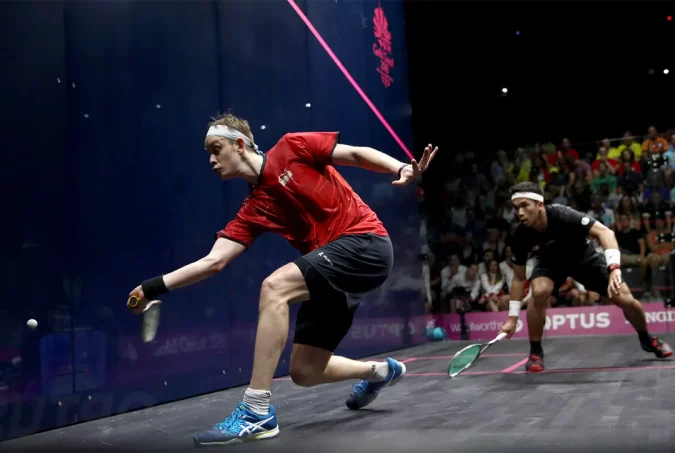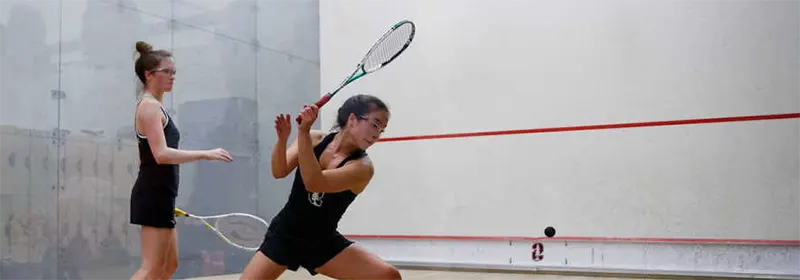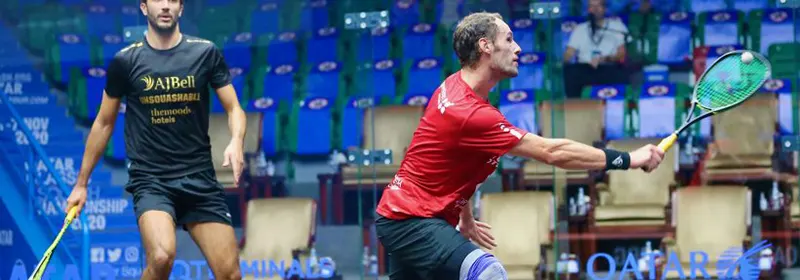02 June 2022 / 3-Min Read / Translate
The relationship between business and sport has never been closer, in fact nowadays most sports are businesses! And that connection goes back further in the way players play and the way businesses run. Both are about competing against an enemy, in the case of business we call them competitors, in the case of sports opponents, but sometimes competitors too, especially in sports where you are not against just one individual at a time; athletics is a good example.

But enough abstract, let’s get down to details! Strategy is the overall plan to win, tactics are the methods used to follow the strategy. So far, so good. Let’s look at some specific squash examples.
Player one is an average club player, who plays two or three times per week depending on their schedule. They may do some fitness training once a week as well. On thing that stands out about them though is how tall they are. Plenty of jokes about “What’s the weather like up there?” and “Bump your head a lot?” the thing is though that Player one wins matches against better players because they volley a lot. They volley a lot because they can, because the have great reach and it’s easier to stick their racket out, block the ball and make their opponent do all the running. Sneaky, or what?
So what would be my strategy? Well, the first thing I would try, and I stress that it might not work, but you have to have a gameplan!, is to tire them out. That’s my first option because tall players have to work hard to move around a squash court. It’s one of the reasons they volley – they want shorter rallies. You might think that’s it’s easier for them to get around the court, “they’ve got long legs!” you say, but the bigger you are, the more work you have to do. Ever noticed how some short players can seem to run forever?! Anyway, so my strategy is to get them tired.
My tactics, in the first instance is to keep the ball either very very high or low. There’s nothing worse for a tall player to have to reach down low and then the next shot reach very high. Yes, very high for you is just high for them, but you get the point. Another tactic might be to begin to hit the ball a little harder than I normally would if I felt that it didn’t rush me too much. A combination of lots of working boasts and high crosscourt lobs would begin to put pressure on Player One’s back and leg strength. Clearly, I’m not going to hit every shot either a boast of a lob, but I am going to be playing them much more than usual.

Perhaps this is the totally wrong strategy or perhaps the strategy is right, but the tactics wrong. Assuming the strategy is right, what other tactics could I use? Well, I would be doing everything I could to stop them volleying. that might mean sacrificing the speed I hit at to ensure I hit tighter to the wall – it’s hard to volley shots tight to the wall. Maybe I try more deception – holding my shots more than usual, covering the ball with my body, using my forearm more – anything to make it hard for them to volley. My last suggestion is playing more drops from the back of the court. Some players are really good at that, but remember, you MUST HAVE practiced them a lot first.
Player Two is another average club player, but is obsessed with fitness. In addition to their three or four squash sessions a week, they always do two sessions of fitness. Player Two can run everybody in their club into the ground. A tough match for you, is a warm up for them! You probably know the type of player I am talking about. Back when I played club squash, we called them “hackers”. Somebody who didn’t have great shots, but could retrieve the ball all day. Players lost against them because they lost patience.
Clearly the strategy we used against player one is not going to work against player two. We need something else, something more nuanced. In this case, a lot depends on whether you have played this player before or not. If you have, then you might have some ideas, if you haven’t then the first game is tremendously important. You are going to have to see what they do well and what they do badly. More specifically, you need to control your desire to finish the rallies early. now, that might sound crazy, because there is no way you can out-rally player two, but what I have seen so so often, is that players go to the other extreme. They look to kill the ball at the slightest opportunity and generally choose the wrong shot.

Player Two wants you to panic. They want you to go for more and more extreme shots because they know they you will often hit the tin because in the back of your mind is the worry that if you don’t hit a perfect shot, player one might get it. And here lies your dilemma. You can’t out-rally them, but you are not a good enough shot maker, at least consistently anyway, to win enough point like this. As you can see, player two is a bigger problem than player one.
My strategy in this case is keep calm and play fundamentally solid squash – why get complicated, why invent complex tactics?. I am going to expect player two to reach 95% of the shots I hit, but not to be frustrated by that. So my tactics are to keep the ball tight, vary the pace, be aggressive on the RIGHT shots and remember my traffic light system:
Red: Defense. Play shots to give yourself time to get back into the rally.
Amber: Probing shots. Play shots to look for weak returns and opportunities
Green: Kill the ball. Don’t assume it’s a winner though, cover the possible return.
My strategy against player One might be different from your strategy for player one. The key here is to understand the relationship between strategy/tactics and strengths and weaknesses of you and your opponent. A strategy that requires tactics beyond your skill level is a bad strategy.